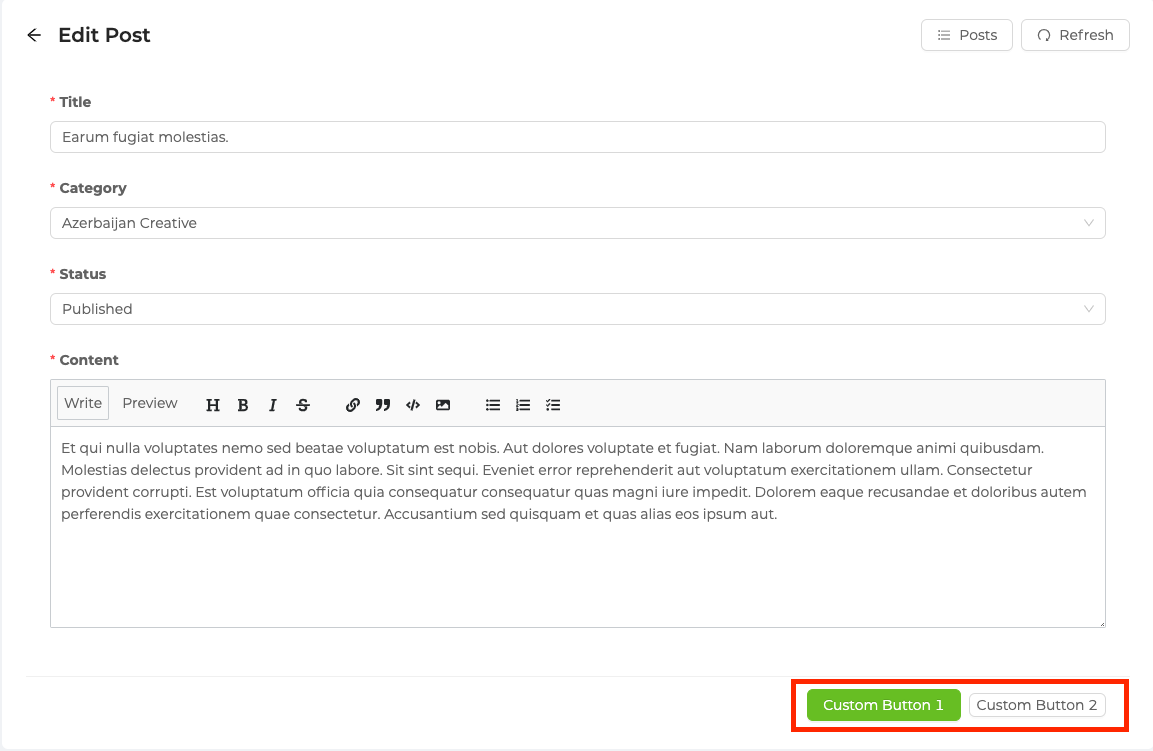Edit
<Edit> provides us a layout for displaying the page. It does not contain any logic but adds extra functionalities like a refresh button.
We will show what <Edit> does using properties with examples.
Properties
canDelete and deleteButtonProps
canDelete allows us to add the delete button inside the <Edit> component. If the resource has the canDelete property,refine adds the delete button by default. If you want to customize this button you can use the deleteButtonProps property like the code below.
When clicked on, the delete button executes the useDelete method provided by the dataProvider.
Refer to the <DeleteButton> documentation for detailed usage. →
import { Edit, usePermissions } from "@pankod/refine";
export const EditPage: React.FC = () => {
const { data } = usePermissions<string>();
return (
<Edit
canDelete={data === "admin"}
deleteButtonProps={{ size: "small" }}
>
...
</Edit>
);
};
Refer to the usePermission documentation for detailed usage. →
saveButtonProps
The <Edit> component has a save button by default. If you want to customize this button you can use the saveButtonProps property like the code below.
Clicking on the save button will submit your form.
Refer to the <SaveButton> documentation for detailed usage. →
import { Edit } from "@pankod/refine";
export const EditPage: React.FC = () => {
return <Edit saveButtonProps={{ size: "small" }}>...</Edit>;
};
title
It allows adding titles inside the <Edit> component. if you don't pass title props it uses the "Edit" prefix and singular resource name by default. For example, for the "posts" resource, it will be "Edit post".
import { Edit } from "@pankod/refine";
export const EditPage: React.FC = () => {
return <Edit title="Custom Title">...</Edit>;
};
actionButtons
<Edit> uses the Ant Design <Card> component. The action property of the <Card> component shows <SaveButton> or <DeleteButton> based on your resource definition in the resources property you pass to <Refine>. If you want to use other things instead of these buttons, you can use the actionButton property like the code below.
import { Edit, Button } from "@pankod/refine";
export const EditPage: React.FC = () => {
return (
<Edit
actionButtons={
<>
<Button type="primary">Custom Button 1</Button>
<Button size="small">Custom Button 2</Button>
</>
}
>
...
</Edit>
);
};

pageHeaderProps
<Edit> uses the Ant Design <PageHeader> components, which means that you can customize the properties of pageHeaderProps.
By default, the extra property of the <PageHeader> component shows <RefreshButton> or <ListButton> based on your resource definition in the resources property you pass to <Refine>.
import { Edit } from "@pankod/refine";
export const EditPage: React.FC = () => {
return (
<Edit
pageHeaderProps={{
onBack: () => console.log("Hello, refine"),
subTitle: "Subtitle",
}}
>
...
</Edit>
);
};

recordItemId
The <Edit> component reads the id information from the route by default. recordItemId is used when it cannot read from the URL(when used on a custom page, modal or drawer).
import { Edit, Modal, useModalForm } from "@pankod/refine";
export const EditPage: React.FC = () => {
const { modalProps, editId } = useModalForm({
action: "edit",
});
return (
<>
...
<Modal {...modalProps}>
<Edit recordItemId={editId}>...</Edit>
</Modal>
</>
);
};
The <Edit> component needs the id information for the <RefreshButton> to work properly.
mutationMode
Determines which mode mutation will have while executing <DeleteButton> .
Refer to the mutation mode docs for further information. →
import { Edit } from "@pankod/refine";
export const EditPage: React.FC = () => {
return <Edit mutationMode="undoable">...</Edit>;
};
resource
<Edit> component reads the resource information from the route by default. This default behavior will not work on custom pages. If you want to use the <Edit> component in a custom page, you can use the resource property.
Refer to the custom pages documentation for detailed usage. →
import { Refine, Edit } from "@pankod/refine";
import routerProvider from "@pankod/refine-react-router";
import dataProvider from "@pankod/refine-simple-rest";
const CustomPage = () => {
return <Edit resource="posts">...</Edit>;
};
export const App: React.FC = () => {
return (
<Refine
routerProvider={{
...routerProvider,
routes: [
{
exact: true,
component: CustomPage,
path: "/custom",
},
]
}}
dataProvider={dataProvider("https://api.fake-rest.refine.dev/")}
resources={[{ name: "posts" }]}
/>
);
};
<Edit> component needs the id information for work properly so if you use the <Edit> component in custom pages, you should pass the recordItemId property.
API Reference
Properties
| Property | Description | Type | Default |
|---|---|---|---|
| canDelete | Adds a delete button | boolean | If the resource has canDelete prop it is true else false false |
| deleteButtonProps | Adds properties for delete button | DeleteButtonProps | <DeleteButton> |
| saveButtonProps | Adds properties for create button | { disabled: boolean; onClick: () => void; loading: boolean; } | <SaveButton> |
| title | Adds the title | string | "Edit" prefix and singular of resource.name |
| actionButtons | Passes properties for <PageHeader> | React.ReactNode | <SaveButton> and depending on your resource configuration (canDelete prop) |
| pageHeaderProps | Passes properties for <PageHeader> | PageHeaderProps | { ghost: false, title, extra: <ListButton> and <RefreshButton> } |
| recordItemId | The record id for <RefreshButton> | string | |
| mutationMode | Determines when mutations are executed | "pessimistic | "optimistic | "undoable" | "pessimistic"* |
| resource | Resource name for API data interactions | string | Resource name that it reads from the URL. |
*: These properties have default values inRefineContextand can also be set on the <Refine> component.